
The Celts or Celtic peoples were a collection of Indo-European peoples in Europe and Anatolia, identified by their use of Celtic languages and other cultural similarities. Major Celtic groups included the Gauls; the Celtiberians and Gallaeci of Iberia; the Britons, Picts, and Gaels of Britain and Ireland; the Boii; and the Galatians. The interrelationships of ethnicity, language and culture in the Celtic world are unclear and debated; for example over the ways in which the Iron Age people of Britain and Ireland should be called Celts. In current scholarship, 'Celt' primarily refers to 'speakers of Celtic languages' rather than to a single ethnic group.
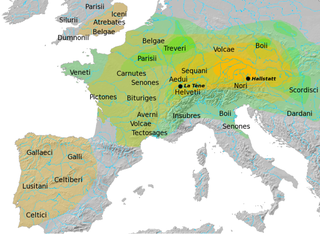
The La Tène culture was a European Iron Age culture. It developed and flourished during the late Iron Age, succeeding the early Iron Age Hallstatt culture without any definite cultural break, under considerable Mediterranean influence from the Greeks in pre-Roman Gaul, the Etruscans, and the Golasecca culture, but whose artistic style nevertheless did not depend on those Mediterranean influences.
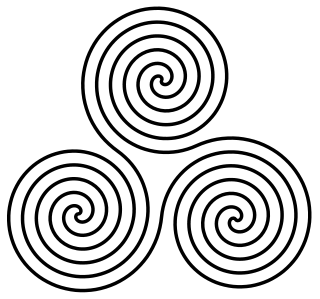
A triskelion or triskeles is an ancient motif consisting either of a triple spiral exhibiting rotational symmetry or of other patterns in triplicate that emanate from a common center. The spiral design can be based on interlocking Archimedean spirals, or represent three bent human limbs. It occurs in artifacts of the European Neolithic and Bronze Ages with continuation into the Iron Age – especially in the context of the La Tène culture and of related Celtic traditions. The actual triskeles symbol of three human legs is found especially in Greek antiquity, beginning in archaic pottery and continued in coinage of the classical period.
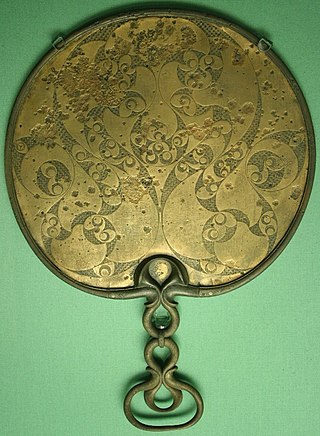
Celtic art is associated with the peoples known as Celts; those who spoke the Celtic languages in Europe from pre-history through to the modern period, as well as the art of ancient peoples whose language is uncertain, but have cultural and stylistic similarities with speakers of Celtic languages.

Ancient Celtic religion, commonly known as Celtic paganism, was the religion of the ancient Celtic peoples of Europe. Because there are no extant native records of their beliefs, evidence about their religion is gleaned from archaeology, Greco-Roman accounts, and literature from the early Christian period. Celtic paganism was one of a larger group of polytheistic Indo-European religions of Iron Age Europe.

Llyn Cerrig Bach is a small lake located between Rhosneigr and Valley in the west of Anglesey, Wales.
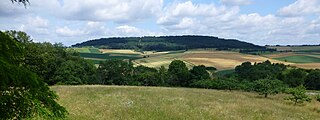
The Glauberg is a Celtic hillfort or oppidum in Hesse, Germany consisting of a fortified settlement and several burial mounds, "a princely seat of the late Hallstatt and early La Tène periods."

Prehistoric Wales in terms of human settlements covers the period from about 230,000 years ago, the date attributed to the earliest human remains found in what is now Wales, to the year AD 48 when the Roman army began a military campaign against one of the Welsh tribes. Traditionally, historians have believed that successive waves of immigrants brought different cultures into the area, largely replacing the previous inhabitants, with the last wave of immigrants being the Celts. However, studies of population genetics now suggest that this may not be true, and that immigration was on a smaller scale.
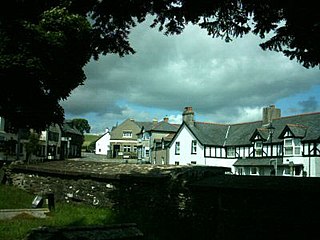
Cerrigydrudion, sometimes spelt Cerrig-y-drudion, is a village and community in Conwy, Wales. Until 1974 it was part of the historic county Denbighshire, when it became part of the newly formed county of Clwyd. When the county of Clwyd was abolished in 1996, the village was transferred to the new Conwy County Borough. The village formerly lay on the A5, but a short by-pass now takes the road along the south-western edge of the village. Prior to the by-pass being built, Cerrigydrudion was the highest village on the A5 between London and Holyhead. The community includes the hamlets of Cefn Brith, Glasfryn and Pentre-Llyn-Cymmer with the village having a population of around 289. The community is sparsely populated and covers over 60 square kilometres.
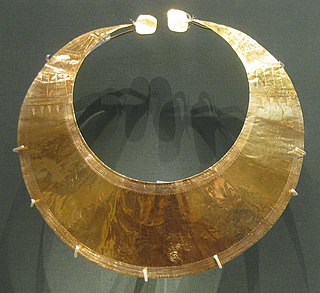
A gold lunula was a distinctive type of late Neolithic, Chalcolithic, and—most often—early Bronze Age necklace, collar, or pectoral shaped like a crescent moon. Most are from Prehistoric Ireland. They are normally flat and thin, with roundish spatulate terminals that are often twisted to 45 to 90 degrees from the plane of the body. Gold lunulae fall into three distinct groups, termed Classical, Unaccomplished and Provincial by archaeologists. Most have been found in Ireland, but there are moderate numbers in other parts of Europe as well, from Great Britain to areas of the continent fairly near the Atlantic coasts. Although no lunula has been directly dated, from associations with other artefacts it is thought they were being made sometime in the period between 2400 and 2000 BC; a wooden box associated with one Irish find has recently given a radiocarbon dating range of 2460–2040 BC.

Oriel Môn is a museum and arts centre located in Llangefni, Anglesey, Wales.

Anglesey is an island off the north-west coast of Wales. It forms the bulk of the county known as the Isle of Anglesey, which also includes Holy Island and some islets and skerries. The county borders Gwynedd across the Menai Strait to the southeast, and is otherwise surrounded by the Irish Sea. Holyhead is the largest town, and the administrative centre is Llangefni. The county is part of the preserved county of Gwynedd. Anglesey is the northernmost county in Wales.
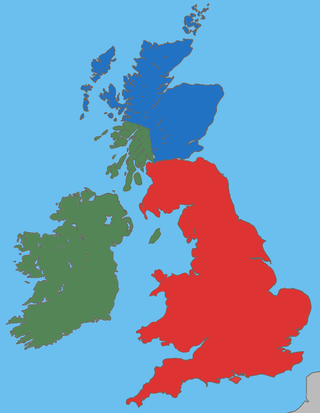
The Insular Celts were speakers of the Insular Celtic languages in the British Isles and Brittany. The term is mostly used for the Celtic peoples of the isles up until the early Middle Ages, covering the British–Irish Iron Age, Roman Britain and Sub-Roman Britain. They included the Celtic Britons, the Picts, and the Gaels.

The Waterloo Helmet is a pre-Roman Celtic bronze ceremonial horned helmet with repoussé decoration in the La Tène style, dating to circa 150–50 BC, that was found in 1868 in the River Thames by Waterloo Bridge in London, England. It is now on display at the British Museum in London.
John Meirion Morris was a Welsh sculptor.

Llaneilian is a village and community in Anglesey, Wales. It is located in the north east of the island, 2.2 miles (3.5 km) east of Amlwch, 16.5 miles (26.6 km) north west of Menai Bridge and 12.5 miles (20.1 km) north of Llangefni. The community includes the villages and hamlets of Dulas, Llaneilian, Pengorffwysfa, Cerrig Man and Penysarn, Gadfa and Nebo, and at the 2001 census had a population of 1,192, decreasing slightly to 1,186 at the 2011 Census. The parish is crowned by its hill, Mynydd Eilian, a HuMP, popular with walkers and ramblers, and its beach, Traeth Eilian, which is popular with holidaymakers and for watersport activities. At the north easternmost point is Point Lynas,, while Ynys Dulas lies off the North East coast of the island, east of Dulas Bay.
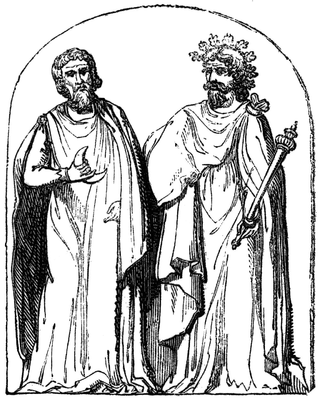
A druid was a member of the high-ranking priestly class in ancient Celtic cultures. Druids were religious leaders as well as legal authorities, adjudicators, lorekeepers, medical professionals and political advisors. Druids left no written accounts. While they were reported to have been literate, they are believed to have been prevented by doctrine from recording their knowledge in written form. Their beliefs and practices are attested in some detail by their contemporaries from other cultures, such as the Romans and the Greeks.

The Deal Warrior, also known as the Mill Hill Warrior, is an Iron Age burial uncovered in Grave 112 at Mill Hill near Deal, Kent in 1988 by Dover Archaeological Group. It is well known for being suggested as the grave of a druid due to containing an almost-unique bronze headdress.

The archaeology of Wales is the study of human occupation within the country of Wales which has been occupied by modern humans since 225,000 BCE, with continuous occupation from 9,000 BCE. Analysis of the sites, artefacts and other archaeological data within Wales details its complex social landscape and evolution from Prehistoric times to the Industrial period. This study is undertaken by academic institutions, consultancies, charities as well as government organisations.


















